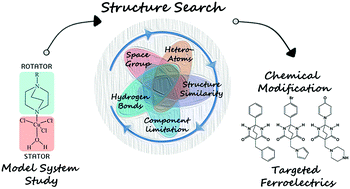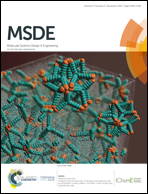Computational discovery of weak-intermolecular-interaction-tuning ferroelectricity/ferroelasticity of pure organic rotator–stator-type assemblies designed through a symmetry/structure-limited structure search†
Abstract
A novel series of pure organic ferroelectrics R1-DABOO-R2 (substituted 3,5-diazabicyclo[2.2.2]octane-2,6-diones) were newly designed by us, serving as analogues and exhibiting the amelioration of experimentally well investigated organometallic ferroelectrics/ferroelastics, R-DABCO-[M(H2O)Cl3] (substituted 1,4-diazabicyclo[2.2.2]octonium trichloroaquo-metal(II)). Combining our first-principles calculations with previous experimental observations, the R-DABCO-[M(H2O)Cl3] model systems were well investigated to demonstrate the structure–property relationship for realizing their ferroelectricity/ferroelasticity. We found that tuning the ferroelectricity/ferroelasticity of the model systems significantly depended on subtle weak intermolecular interactions changing with the substituent R groups within each crystal. Thus, the design principle that the rotator–stator-type assemblies should hold rotational dynamics and characteristic space groups to easily switch ferroelectricity/ferroelasticity and get rid of weak metal coordinate bonds to increase their thermostability was proposed to conduct an effective symmetry/structure-limited structure search from the existing crystallographic structure database. The ferroelectric/ferroelastic R1-DABOO-R2 series were located, and the further delicate chemical modification of their substituent R1 and R2 groups was performed to reserve specific weak intermolecular interactions in these molecular crystals to finally realize their ferroelectricity. Three new ferroelectrics, namely, 1-benzyl-4-phenyl-3,5-diazabicyclo[2.2.2]octane-2,6-dione, 1-pyrrol-1-yl-methyl-4-(4-bromophenyl)-3,5-diaza-bicyclo[2.2.2]octane-2,6-dione, and 1-piperazin-1-yl-methyl-4-(4-oxo-4H-pyridin-1-yl)-3,5-diaza-bicyclo[2.2.2]octane-2,6-dione with their spontaneous polarizations of about 1 μC cm−2 were designed, and we are waiting for their future experimental confirmation. Our developed novel design methodology of organic ferroelectrics/ferroelastics from the model system study (building the structure–property relationship) and structure search (following symmetrical and structural principles) to delicate chemical modification (tuning weak intermolecular interactions) would surely inspire the experimental and theoretical exploration of new ferroelectrics/ferroelastics with specific molecular dynamics to switch the phase transitions.



 Please wait while we load your content...
Please wait while we load your content...